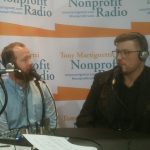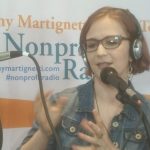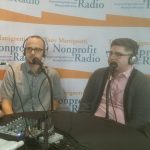I love our sponsors!
Do you want to find more prospects & raise more money? Pursuant is a full-service fundraising agency, leveraging data & technology.
WegnerCPAs. Guiding you. Beyond the numbers.
Credit & debit card processing by telos. Payment processing is now passive revenue for your org.
Fundraising doesn’t have to be hard. Txt2Give makes it easy to receive donations using simple text messages.
Get Nonprofit Radio insider alerts!
Listen Live or Archive:
- On Fridays at 1pm Eastern: Talking Alternative Radio and tune in
- Listen to the August 17, 2018 archived podcast
My Guests:
James Wu, Kristyna Jones & Rhiannon Tasker: Branding
How do you get people to care about your brand and your cause when there’s so much noise out there? It helps to be inclusive and authentic. Our panel from the Nonprofit Technology Conference (18NTC) explains how. They’re James Wu, brand consultant; Kristyna Jones with Brothers Empowered 2 Teach; and Rhiannon Tasker from The Public Theater.
Steve Rio: Focus and Attention
 Steve Rio has been researching the intersection of mindfulness, creativity and productivity. He’s CEO of Briteweb.
Steve Rio has been researching the intersection of mindfulness, creativity and productivity. He’s CEO of Briteweb.

Top Trends. Sound Advice. Lively Conversation.
Board relations. Fundraising. Volunteer management. Prospect research. Legal compliance. Accounting. Finance. Investments. Donor relations. Public relations. Marketing. Technology. Social media.
Every nonprofit struggles with these issues. Big nonprofits hire experts. The other 95% listen to Tony Martignetti Nonprofit Radio. Trusted experts and leading thinkers join me each week to tackle the tough issues. If you have big dreams but a small budget, you have a home at Tony Martignetti Nonprofit Radio.
Get Nonprofit Radio insider alerts!
Sponsored by:
Processed on: 2018-11-11T23:53:34.332Z
S3 bucket containing transcription results: transcript.results
Link to bucket: s3.console.aws.amazon.com/s3/buckets/transcript.results
Path to JSON: 2018…08…403_tony_martignetti_nonprofit_radio_20180817.mp3.200276731.json
Path to text: transcripts/2018/08/403_tony_martignetti_nonprofit_radio_20180817.txt
Oppcoll hello and welcome to tony martignetti non-profit radio big non-profit ideas for the other ninety five percent on your aptly named host today’s show is dedicated to my mom. She would have been eighty five today would have been her eighty fifth birthday. Hi, mom. Oh, i’m glad you’re with me. I’d be hit with zoho no sis, if you made me sick with the idea that you missed today’s show co-branding how do you get people to care about your brand and your cause? When there’s so much noise out there, it helps to be inclusive and authentic. Our panel from the non-profit technology conference eighteen ntc explains how they’re james woo brand consultant christina jones with brothers empowered to teach and ran in tasker from the public theater and focus and attention, steve rio has been researching the intersection of mindfulness, creativity and productivity. He’s ceo of bright webb on tony’s steak, too, baby boomers, we’re sponsored by pursuing full service fund-raising data driven and technology enabled tony dahna slash pursuing capital p wagner, cps guiding you beyond the numbers regular cps dot com bye tello’s durney credit card processing into your passive revenue stream tony dahna may slash tony tell us and by text to give mobile donations made easy text npr to four, four four nine, nine nine here is branding from the non-profit technology conference welcome to tony martignetti non-profit radio coverage of eighteen ntc that’s, a non-profit technology conference in new orleans hosted by the non-profit technology network interview like all our eighteen ntcdinosaur views is sponsored by network for good, easy to use donorsearch and fund-raising software for non-profits my guests are james wou christina jones and ran in tasker. James is an independent brand consultant. Christina is co founder and ceo. Seo of brothers empowered to teach by here in new orleans. Andre hannan tasker is donor communications project manager at the public theater. Welcome. Thank you for having a pleasant have all three of you. Your workshop topic is branding for the apocalypse very ominous how to get people to care about your cause when everything is horrible. Okay, eyes the horrible that we’re, uh, is part of the horrible that we’re thinking about the current political environment and how there’s something new every couple of hours. Do you like he’s a crisis? Yes, that that is exactly what we’re talking. About that was certainly that’s the driver of the conversation and that i remember one day, you know, logging off twitter for about thirty minutes, coming back on and literally, there are six new horrible things that happened that we’re very much tied to the current political climate in the country we just learned a couple hours ago that paul ryan is not going to run for for the house in wisconsin. Well, there you go. Speak something about what’s going on on dh there’s news like that very, very often. Yeah, our challenge is to stand out, okay? Apocalyptic? Yeah, we have an apocalyptic e i mean, i think that the khan, the environment that we’re in right now is very divided. And no matter how quickly things change and how every how fast news is happening, it still feels like we’re in a very sort of divided world in the way that we’re feeling after post election, especially no matter what side you’re on it’s feeling very divided and very sort of there’s a lot of tension right now, and so it feels a little bit of tense and uncomfortable sometimes, okay, but, kristina, we can’t overcome your your organ has done it. I guess you’ve got some lessons to share. Yes, i think that we have overcome that because one of the things that we always do, regardless of what’s happening politically in the world stay true to who we are is an organization. So, you know, part of you know, your branding is sort of interpreting that message for what’s happening in the world as long as it’s a part of who you are. Okay, so, is that your first advice for rising above this noise is staying true. Yes, you are. I think so. I think what happens when we have these, you know, something, something that happens with non-profit sometimes is that wear always putting out a fire, right? We’re responding to a crisis. And in responding to those crises, sometimes we can lose a part of who we are or staying kind of on message of what we’re trying to accomplish or what our mission is. And so i think it was sort of like being i think i used on the panel today is like being a bully and a storm, right? So that’s, my part might take. Okay, so your panel’s already done. You’re relaxing them. That’s. Right, guys, take it easy on us. All right? Congratulations. Yeah, this is fun. This is not from radio. No, no, you got yours here. Anything okay? And i gather from the session description. Christina and rhiannon. You’ve taken two different approaches in terms of politics. Hyre christina apolitical. Pretty much staying mostly apolitical and reaction. Uh, using the arts to be political, using theater to be political. Yeah. Anything, something about the public theater as we try and represent all sort of views were opened everyone and we want to tell all stories and especially in our branding, we did the same thing where we said, very true to who we were as an organization and the urgency that people are few going in the community in the power of storytelling, to sort of tell people to share different perspectives and the power that storytelling really has. Teo help people feel like they understand a different viewpoint than their own, whether that’s, depending on all sides of the political spectrum, i mean the public theater being in new york city, we do tend to lean a certain way, but we try toe be as open just all, all voices in all stories on dh, hopefully help other people understand, especially as i said, we’re divided right now, helping understand other people and under perspective helps sort of refused attention and help people come in issues in a different way. James, i think it’s pretty well recognized that storytelling is critical. We’re not a theater group that has a stage literally, yeah, how can we effectively, compellingly is better. Tell tell, have the storytelling or telling ourselves yeah, yeah, that is a great question and one question, that question that doesn’t have fans, we have to have a fan, i have know that we’re seeing a james now you both way or lindsay is a small town, there was astra, everybody about each other’s people and your, uh, your home i’m leaving now way that was legitimate, okay, just kind of make up having any family. So how do we do this compelling? You know, that’s a great question is actually question that came up in a in our panel conversation today from the audience and ran and answered it beautifully, and i’ll try my best kind of encapsulate her great response in that. At the end of the day, yes, we might not be affiliated with an organization that is in the arts or in the future, or use this storytelling as the primary medium or platform. But the work that were in in the nonprofit world is all about human stories, right, it’s all about change and transformation within humans and communities that they dwell in, that we serve. And so i think at the end of the day, you know, you might not have art as kind of the channel for telling these stories. But the better you can get at telling very human stories that connect to people at a very human emotional level. I think that’s, where you get really, really, really power. How do you do drill down into that? Getting that making that connection with with the leader of the viewer? S o i think one of the mistakes that a lot of organizations do is they get caught up in kind of explaining their model like this is our theory of change. And this is here all of our programs, right? We invest in building community, we invest in entrepreneurs, whatever it is way train leaders instead of thinking about why, like, why do you exist? What is your purpose? What is your reason for being right? If you can start there, then you can begin inspire people in a way that if you start talking about your products and programs, you might lose them. Right? So if you can start with why you exist, really drill down and get to your core purpose. I think anyone can really identify with that. Begin. Teo, resonate with that message. It’s. Time for a break pursuant the round up the fund-raising round up it’s called the pursuing e-giving outlook. They took all the latest fund-raising reports. Boiled it down to just what you need to know. Plus they did a webinar on it. And you can watch the archive of that it’s, an ensemble piece, the content paper and the webinar both. Are on the listener landing page that is at tony dot m a slash pursuant remember the capital p for please. Now, back to branding. Cristina’s doing a lot of nodding. Yeah, i what’s your way, you know, brothers and power to teach, unlike the public fears only four years old, right? Um and so we’re still kind of a startup, but when we first started, it was very much like, this is our model. We have these three steps. This is what we do, and people would be like dahna and so when we started telling the story about why we do the work and why we think the way we do, it matters, it was much easier for people to connect. And so i think that that’s really, really important and you’re trying to get black men to go into teaching, right? Right? Education. That’s right, brothers? Yeah. Weather’s empowered to teach brothers and power to teach and sister bras and power to teach. But, yes. Okay. Okay. Uh, and you’re you feel like you’re creating a lot of boats and a lot of conversation around your mission. How? Yeah, on the way of rising above you, get talking about you? Yeah, i mean, uh, one of the things that i said today was that, like, show up, right? So we show up to lots of different things, and we show up in lots of different ways. So we participate in lots of activities going on around town related to the issues that we work on, but also on larger issues like there’s, an initiative in new orleans called forward together politicians non-profits people who work in the private sector come together, so we go to those things. We’re all constantly wearing a b, right? So that’s one of your share, one of the ways we show up the every way is that we know on your shoulder turned my shoulder way. We have young people who are very much engaged in the work that we do, and so they do a lot of videos for us. They do a lot of tweeting for us. They we do a lot of social activities, so people see us collectively together, and they’re like, what, that beaming? What hashtag real bro teach? What does that mean? So that’s how we really driven people to think about it, brandon, how about the public theater. How are you creating buzz conversation about about the pub. I mean, the public theater is a definitely a growing brand, especially in new york city. We had hamilton, which was like a huge, huge threat. Hamilton before was on broadway. Yeah, we created hamilton here the way we did the workshops and, like, sort of helped. It could be that show. And then we did the first production. That was the production that moved to broadway. So we had a lot of sort of, like buzz from that show. And i were now in the place of like, okay, now that hamilton’s sort of moved on, continuing those conversations and keeping us in the forefront of people’s mind as a theatrical in student as well. Civic inge institution. We hold a lot of talk are that are hosted the republic form team at our home in astor place. We also were doing them a delacorte. We hold other sort of initiatives. We did. Voter registration was a big thing. We had a table on our lobby on bistro. Participated with other non-profit geever okay. Interesting voter registration. That’s. Um, that’s. Not something that intuitively i would. Link with with a theater? Yeah, it was initiative that was started by believing playwrights horizons. They got theaters throughout the country to set up voter registration foods for when people came and saw shows they could register for vote while they’re like waiting in line or internet during intermission or after the show. And the idea is just to help people engage civically within their communities in the country by voting, and we had a huge turnout. We also did some pushes on our social media and through emails, and we got a lot of people registered to vote and it’s our way of sort of helping people just be active within our community and engage socially not just with the conversations that we’re having with the work we’re resenting, but just like in the real world outside of what’s on our stage is james, you’re our resident consultant. How generally, how can we create conversation and buzz around our work? I mean, i think we just heard some great examples, but beyond those, yeah, i think it does at the end of the day, come back to having a clear sense of who you are, but also who your audience is and we talked a lot today about authenticity, right? Yeah, doing here too, yeah, allowed on non-profit radio on and i think the theme of authenticity is something that we keep the three of us keep coming back to and is a common thread in all of our work. But, you know, like rian instead of beginning organization that’s yours and organizations that tend to shift their messaging or change, they are in response to what’s happening the world today without remaining true to kind of their core purpose or kind of their their identity. I think there’s a real danger, they’re kind of losing sight of what you’re all about and why you exist. I think when you have a clear sense of who you are and more importantly, how your audience connects with that, then that kind of authenticity shines through no matter what is happening around you. And i’m sure these to concede say more about that. Yeah, i think a lot of the questions we have today, no matter what the question was, are always kind of brought back to that authenticity and who you are and sticking true to who you are. Whether it is like a post election end of your campaign where there’s a little different urgency within it, it’s still about those fundamental things that make your organization what it is people are going to see right through you if you’re trying to, like, do something urgent, that doesn’t feel authentic or real because they don’t want to give money to an organization that’s not going to do something with it, that’s what that is fundamental to who they are, and so the public theater and, like we have always stuck true to those values that were theater of by and for the people on that culture belongs to everyone one and this is we are places, storytelling, and those are the things that are important to us and just framing it in the way of the moment of it, whether it’s urgency or what, no matter what it is, it is it’s still, those things at every question we got today, we kept coming back to that authenticity and who you are, because, christina, you’re not only alienating your mission, but you’re also alienating your core supporters, right? You’re awful, haley expecting work for you, you and your employees, your staff, they have certain expectations. Now we’re adjusting just because there’s tha multi in the in the political economy, right? Exactly. I mean, we think of our brand is a person, right? So one of the activities we did when we did our brand refresh was okay. His brothers and power to teach was a person who are they use a person? This ah, james is a user persona, or i think that’s part of it certainly part of it and so, you know, kept coming up with all the things that we already do that sort of reinforce who we are as a person, so we’re twenty something creative, collaborative, fresh and fashionable group what we read, what we listen to way to our podcast, you know, all about those things that connects our brand to people who want to hear about the work we’re doing in more detail, and it translates into the photos we take into our website. All of those things signify that you think, tony, you just used an interesting word a minute ago, and then there was expectation, and i think, that’s one thing that we actually didn’t talk a lot about. Directly today but certainly was a theme that i see woven in a lot of the work, especially the tactics that both of your organizations have used in the past year and can be something as small as the public theater in there. You’re an fund-raising campaign last year instead of their typical just we’re just going toe send email after email appeal at the end of the year asking for our audience to give us money they actually hand wrote notes on postcards thanking people for their contributions for their engagement, a very analog old school approach in this very hyper, you know, social media, digital world, and they saw a huge bump in terms of kind of hoping to see a big bump in terms of renewal sze but did see a big bump in terms of engagement, justin, based in response to that tactic, which so that kind of analog very old fashioned, if you will approach really, really cut through the clutter when you’re just getting bombarded on social media or email today and similarly with brothers empire to teach, i think one of the things that was really interesting when they were going through their brand refresh. They had an exercise where there, you know, looking at something as mundane as colors which should our color palette be that represents our visual identity. It’s a very standard part of any branding exercise. But the way that they thought about colors was really provocative for me. And i should probably just, like christina tell the story herself. But essentially, you know what? What i heard was correct me if i’m wrong that yeah, you tell us. Thank you. S r color palette is soft. So its environs so it’s yellow, teal of, like, a lavender. And i grayce right. And the reason for those colors is because we did this today we had all feel like you’re hearing. Yes, you’re going down going down with you. Eventually wei had everybody close their eyes and say and think to themselves, not necessarily share like you think of a young black man. What do you see? Right? And so when they open their eyes and said the reason these colors are the colors they are because they signify liveliness and collaboration and nurturing. So a softening of the idea of a young black man is because we want people to see young men as nurturers, right as having potential to nurture so that’s why our color palette is the way it is. We talked about this idea of i used to come from the international development world in this this expression or phrase club poverty porn. But if you’ve heard that but it’s kind of this, you know, in our imagery we either really negative imagery that’s very exploitive in an effort to raise money and awareness, right? So malnourished kids and sub saharan african with flies on their faces, right? That kind of creates this sympathy or pity. On the other hand, the pendulum has swung in the complete opposite direction in the last five, ten years, where everyone uses just images filled with happiness and optimism and joy. And i feel like there needs to be a recall calibration again and something that’s kind of in between that prevent presents a mork, nuanced complete hole and maybe complex picture of what the issues are that we’re dealing with in the communities that we’re serving. I think that there’s a real danger and kind of dumbing down your message rebrand or simplifying it to say, this is this is who we are, this is what we’re all about and it’s it’s kind of playing into what people expect right versus some little what brothers in power to teach duitz he said, how do we create an image that is more about fostering this nurturing environment? And then also in some of the photographs, you see it’s, like, sometimes it’s really struggle on diversity that you see sometimes it’s real celebration enjoy and just the complete humanity that’s presented kind of a whole human being, i think that’s um, something that we don’t see enough of today, christine what’s a home run for you is that when when someone decides to and embark on a career in education is that i like the grand slam home run and a stadium fans would be if a young man starts with us and doesn’t want to teach, and by the time he leaves he’s like you know what i’m going to teach. So that’s that’s a grand slogan, the basic home run is basically a young man who should, who may want to teach what isn’t really sure and decides to teach, but we’ve had a lot of success with guys who had no intention of teaching because only three percent of all the teachers in the entire country are black men, they don’t see themselves and teaching, so the idea that they now see themselves with the teacher or working in education period is like, phenomenal, really, yeah, and you talked a bit about inclusive hyre say more about that in terms of the public’s brand. How do you feel being inclusive sets you? Aside from competition in new york city, the public theater, it’s one of our fundamental sort of missions is tio provide theatre to everyone no matter what background you are. And i mean, if we dio free shakespeare in the park where we give one hundred thousand tickets, world class shakespeare every summer, all for free heart is held to get to former new york come on, we’re making i mean that’s the thing that they are hard to get, people have to wait in line for hours. So what? We’re taking steps to make it easier to get tickets for everyone. So we do distributions in all five boroughs. We like what they’re like throughout the week we’ll be, we’ll be in queens one. Week will be in brooklyn will be in the bronx and staten island dahna distributing tickets there so that they don’t have to come into the city, wait in line for hours, maybe, or maybe not, get a ticket and then wait until the show in the evening. It’s a more accessible moment for them to get tickets there. We also have a digital online lottery so people could do it from work or from where they are. We do a lottery downtown, it are after a place home. So again, you’re not waiting in line. You can come enter the lottery, get john, be quick, we so we are trying to you offer more and more opportunities to help like to help expand who is seeing the theater versus the people who are able to write in line. We also do the mobile unit, which takes shakespeare to prisons, homeless shelters and community centers do out all five boroughs, and we do that twice a year. Once a year, we’ve now expanded twice a year, their twenty stopped tour, and then they come downtown and dio a three week, three week run at our theater and astor place and all those tickets are also free inclusion. Yeah, well, i just want to talk about. No, but the wraps. Okay, what else could we talk about you, you had your your workshop. We’ve got another five minutes or so together. What happened? We touched on anybody that we want to. You did ninety minutes. I know. We’re all talked out questions, maybe questions you got that we haven’t talked about yet. Well, one thing that that we didn’t that didn’t come up, that some folks ask me after our panel was, you know, it’s it’s interesting because you have a very founder lead organising your small organization, you’re young organization upmifa on the contrary, public theatre has been around for sixty five years, almost and their founder is not, you know, directly involved anymore, but oscar eustis who’s been there for how long? It was ten years when i started so twelve, thirteen years he’s kind of an iconic institution in another sound. And so how do you think about brandon relation too? The founders personality, and if you work in an organization that doesn’t have a strong founder with that really influences that culture than then what do you do? I don’t know if you guys have thoughts on that. Well, i’ve worked in no book fired-up buy-in my previous career, i was investment banker, community development and one organisation i work for went through a big brand refresh the founder had long been gone and what they did. Internally was sort of theater does with the stash and sent out a survey. Like, who are we way say we are. Who do you think we are? Wait, you think we should be? And they did a whole entire brand refresh based on sort of who’s in the building. Now, who works for the company now? Why did they come to this place to work here? And i think they did a great job rebranding themselves. Enterprise community partners. I haven’t looked at co-branding lately, but a few years ago, they did that. I thought that was a really great way to do it when you don’t have a strong founding founders culture anymore. The founder has, you know, your organization has evolved over the years. You’ve had another executive director, but you still want to stay kind of truth to your original mission. I thought that that was a great way, actually. Survey surveyed the staff surveyed the stand. Why are you here? Right? Right. Right. And i guess you know another question. Taking that a step further that i get all the time. Okay? We were sold. We should go through a branding exercise. That brand refresh. If you will, how do we get the leaders of our organization on board? How do we get the entire staff on board to really buy into this? So this doesn’t just feel like a bunch of pretty words that we stick in a mark getting drawer, but has riel impact on how we show up in every department throughout the organization every single day. So how do we get that buy-in that’s my question, i don’t know, i mean, you guys are both live and breathe this every single day, and i’m happy to share my thoughts, but i mean it’s, the public theater is such a deeply rooted mission and oscar, whose artistic director really lives and breathes the mission of the public and truly the people who work there want to be there. I want to be there for the mission of the public it’s, you know, it’s non-profit you want to be there for that, you you want to be there to help give thousands of people free tickets in the park and the work that goes behind it and to create good work. So we are kind of in a a very lucky situation and that we are very, very rooted in our mission and our brandon who we are on it, it stuns from having a strong artistic director leader who any speech he gives any from, like a staff meeting, agreed to the delicate and opening night of shakespeare in the park. It is so rooted and who we are and so rooted in the deep belief of who we are every so it really helps everyone in the organization really get behind it because you know that you’re working towards something not for our leader believes and i also that’s something that we believe in a cz group and as a theatre, so we’re kind of we’re lucky and that our way it’s so embedded in us is a public you don’t know, a lot of cedars don’t necessarily even have that theater is not something that people think of in these huge, huge, deeply founded missions and values and big we have brought their broad and really lofti of culture belongs to everyone and theatre should be free for all and all those things that but there are things to aspire to and there things that we all are working towards. Is an organization, james, if we don’t enjoy that luxury that the public has yeah, you yeah, i think one of the biggest things that i tried it teach my clients is that when they’re going through branding, exercise, it’s really critical to bring the entire organization on board throughout the process, right? There’s, nothing worse than going through a six month rebranding and the leadership says tata, we’re done look at our new brand and he says, what, like, how come i didn’t have my how come i wasn’t hurt happened? I didn’t get a chance to weigh in or at least share my opinions or and so i think that’s a really, um, the fine line between, you know, a successful branding and co-branding that ends up failing one of the i think it comes down to when you’re when you’re developing a mission or purpose statement, if you’re developing core values for the organization that you don’t fall into the trap, which is choosing empty words, right? We’ve also core values like empathy, innovation, honesty, well, who’s, who’s not going to be honest, like, who wants to be the opposite of that, right? So those kind of be empty, meaningless core values. How can you create a set of values that really change the way we show up to work every single day? And so one of the things that i do is my clients is after we have this branding, we bring everyone along throughout the process there entirely bought in, we say, okay, now we have this new set of values. Now we have these new purpose. Maybe we’ve written a manifesto. Really? Look at these words break up into teams. So finance department, accounting department marketing department operations team i want you each to go and meet and look at these words and really understand what they mean and have a conversation about what’s going to change. What you going to start doing mohr of today that you’re not doing enough of what you going to stop doing as a result of the language on the words at the end of the day, a lot of rebranding tze come down to a language and words and the intention that you put into those really can go a long way. Okay, we’re gonna leave it there, ok? Alright, right they are james woo, independent brand. Consultant christina jones, co founder, ceo of brothers empowered to teach rehan in tasker dahna communications project manager at the public theater. Thank you all. Thank you all very much things interview scheduled sponsored by network for good. Easy to use donor-centric software for now. Non-profits thank you so much for being with non-profit radio coverage of eighteen. Auntie si. We need to take a break. Regular cps, please talk to eat. Which tomb? You heard him on the four hundredth show. Plus he’s. Been a guest on the show a couple of times. Check out the firm. Of course. Do your research, then talk to e tell him what you need. He’ll tell you whether wagner can help you with your accounting needs. No pressure, all professional. Got to do your due diligence. Get started at wagner cps dot com now, tony’s, take two. I’m paying attention to baby boomers. Millennials get a lot of attention. Of course on dh that’s deserved. That could be a very, very important part of your fund-raising prospect pool course. Depending on your mission, they’ll be donors for fifty or sixty years. I am not saying ignore millennials at all we’ve covered in here on the show many times what the trends involving millennials, etcetera and will continue to but that i don’t mean that is the universal no gator along with that my consulting, and hence my focus is on baby boomers. They’ll be around because i’m one and i’ll be around for a good forty years. Actually, i’ll be around for another forty four because i’m living two hundred so they’ll be around there’s a lot of wealth in the baby boomer generation, they have proven to be generous with their wealth, lots of reasons to pay attention to baby boomers and to promote and market the state and retirement plan gifts to them, as well as paying attention a millennial’s again, this is not an either or depending on your mission and depending on the makeup of your constituents, they may both very well fit in. Okay, my video saying a little more on that is at tony martignetti dot com it’s my pleasure to welcome steve rio to the show. He is founder and ceo of bright webb, a social impact consultancy delivering strategy, branding and digital. He aims to build the world’s most flexible, engaged and efficient company. He’s, an expert in exponential organizations, remote and distributed teams and workforce, wellness and performance. He consults with impact leaders to reimagine their organizational strategies, systems and company cultures. The companies that bright webb b r i t e web dot com and he’s at steve rio. Welcome to the show, steve. Hi, how are you? I’m very well. How you doing? I’m doing great. Good. Were you calling in from? I’m calling from my home office on bowen island in british columbia, canada. Wonderful bowing island. How far offshore is bowen island? Probono island is the closest island to vancouver. It’s about a twenty minute fairy. But it’s a small little community about thirty, five hundred people. So just a small, small island. Okay. And you’re a good, uh, i don’t know. Six, seven thousand miles from new york city. That’s about right. That’s. All right. Right now. Yeah. Okay. That’s where i’m sitting so, uh, okay. It doesn’t matter who got twenty. Eighteen. It hasn’t mattered for a long time. Okay. Um, you’ve been you’ve been spending a lot of time learning about researching the science of focus and attention. What? What? What brought you to this? Yeah. So, i mean, i’ve been thinking about this, i guess, as a leader of a company of about five years ago, we moved to more of a remote model where we’re kind of embracing twenty first century practices around, you know, organizing people, so we started allowing people to work remotely and and travel while working and doing things like that. And then a couple years ago, we launched a distributed workforce of freelancers, so we have freelancers in twenty five cities around the world now and, you know, over that time, one of what i’ve learned for knowledge workers there’s an increasing onus on the individual to think about how they manage their time, their work have it how we organize our offices, whether those air, virtual or physical spaces and just really thinking about, you know, the capacity and capabilities of our teams. And so i guess even for myself thinking about how to maximize productivity and howto really achieved the most impact i can have in the work we do it’s become a key part of my thinking on howto really maximize their teams. So it’s been a few years now where i’ve been focused pretty heavily. On this subject did you used to have a more traditional office where all our most people worked in one place? Yeah, i guess that would have been about four years ago was when we started making that transition. We were we were working out of an office. So we have an officer, vancouver. But we serve clients mainly in the united states. So we have an office in new york as well. So as soon as we had two officers that’s when we started to think about howto have you no more of a distributed approach toe work. And so four years ago, we started making that transition. Okay, i see what drove you to that. All right. So you could have come to the studio. You you could’ve visited the new york office and come to our studio here. That’s, right? But it happens to be summertime and summer time on the island is pretty good. So i understand how you could be with you in new york. That’s okay? We tried, tio. We tried to, but the schedules were just, you know, i’m not in new york all the time, either. I’m, uh, i spend a lot. Of time in north carolina, where the beach yes, i have a beach house there, and the beach is also very nice. During the summer, you might have heard rumors to that effect the ocean and beach life. Very nice in the summer months. Um, yeah, okay, so you’re and you’re interested not only in the not only interested, but you’ve been spending time researching not only the conscious aspects of this, but unconscious earth. Yeah, well, so to me, there’s sort of a couple of key components. One thing is how we organize our time. You know, i think about this from if we’re thinking about the social sector, which is who our clients are in a lot of who i consult with and work with. I think about the capacity of our teams because i think we have pretty severe limitations on budgets on operational budget specifically and thinking about howto increase the capacity of our workforce. And i think one of the ways we can do that is by really looking at the way we structure our time and the way we you know what kind of habits we reinforce in the office place and i think first off, there’s the component of just getting focused, work done and thinking about distractions, thinking about how we’re implementing technology and the sort of core components of that, i think a second component is around creativity and around creating space and allowing people actually have the time to think big and come up with creative solutions, which doesn’t happen in a busy, distracted work environment. And when you’re right in front of technology all the time, it kind of requires ah level of space to be created for people and so let’s. Ah, let’s, get some ideas. How do you how do you create that space? So i think creating spaces, it comes with first off and understanding what it means, you know, what’s interesting, like, you know, we’re starting to work with universities in canada as well as the u s and thinking about how we start to educate people from a younger age about what it means to be productive. I think we have, you know, his knowledge workers. Most of us are knowledge workers in today’s world who were working in front of a computer, and we’re creating documents or information products or things like that. Were a lot of communications, so oftentimes we feel like productivity is time spent in front of the computer o r on our devices and and i think it’s really important to realize that productivity and creativity comes also when you create space, when you go for a walk, when you take breaks when you actually disengage from the, you know, actual document creation or the actual work you’re doing and take time to process what’s happened so what’s interesting is that we have a conscious mind in a subconscious mind, and, for instance, when we learn new information, um, about six percent of that goes into our conscious mind, which is immediately available, and the other ninety four percent goes in our conscious mind, and that takes time to process and that’s where we kind of put things together and think that’s where correlation happened, that’s where true creativity happens. So, you know, i think most people would, you know, relate to the idea of the best ideas might come to them in the shower when they’re doing the dishes or when they’re, you know, doing some task that requires very little cognitive effort and that and that’s when our creativity strikes, and so what i what i try and teach my team and what i talked to people about in our workshops and the work we’re doing is about think rethinking what productivity’s means and how creating space in your days and you’re weak can actually be a very productive way to be a more creative contributor to your work. This reminds me of the dark days when i practiced law, and in those days we didn’t have why didn’t you have a computer at my desk? We’re talking about nineteen, ninety four, nine, nine, nine nine to nineteen ninety two andi i i’d have to stare at a blank ledger every day, and i knew i had to fill it up with atleast ten hours of billable activity. Otherwise i’d be working that weekend to make up the difference, and there were all kinds of building codes for for producing tangible output, but there was never a code for thinking. You know what? I just spent time thinking about your case, thinking about what the best strategy would be thinking about how to manage the relationship with this adversarial party, but i could never build for i thought and i i i had to build it into some document, some letter memo to the file or to the client that i had written this thinking time was never a billable activity, that it wasn’t a recognized thing that we should ask clients to pay for. Yeah, sorry, we feel the exact same thing as a consultant, you know, we were able to build for designing a website or creating a strategic brief for leading a workshop, but a lot of that that the thinking time is sort of out in space that we’re not. We’re not ableto billed for, which creates on, as, you know, an inverse relationship with the actual quality of the work that we’re trying to deliver. Yeah, wait, we just have a minute before a break tell me how you enforce this. How do you get people to it’s create this white space in their in their work days? Well, i think you just i mean, it’s been very interesting trying to implement this with my own company over the last couple of years and the hardest route to do this with his with young folks with the millennials grownup as digital natives. In so it’s kind of repeatedly letting them know that they’re a part of their job is delivering value like deep, valuable thinking, and to do that, they need to create some separation from technology and from their devices, and they need to create space and so really encouraging people to get up and walk around to take way. Taking meditation moments through our days, we have these virtual meditations we do throughout the week that are just three to five minutes, because i don’t think it could be. It could be a short period of time or a longer period of time longer the better. But even to destry minutes can make a big difference in your day where you’re actually fully disengaged in either in a short meditation or even just day dreaming and looking out the window. Hold that’s all we’ve got to take a break. Yeah, tell us you’ve heard the tell us mony als from charities that referred companies for credit card processing and, of course, they’re getting the revenue each month on dh from companies who are using tello’s for credit card processing can use more revenue big question can use more revenue that long stream of passive revenue. Ah, i’ll bet you could watch the video at tony dahna slash tony tello’s that’s the way to get started now back to steve rio. Steve, i am guessing that a part of this is the especially the millennials where the tougher nuts to crack, he said they need to see you doing these things a swell like you’re you’re taking the virtual meditations with them, of course, that’s, right? Yeah. So so i think i mean, i think what’s very key for organizations realized that has to start with leadership, and so i think in my case, i’m the ceo of my company, i’m the founder of my company, so i’m ableto teo live this toe live this thes recommendations and these ideas and to really create that opportunity for people to pick it up. Now, it’s a serious behavior change for a lot of people who are very accustomed and, you know, perhaps addicted to their devices into being engaged with technology and those things so really creating behavior change, which could take some time, but it does start with leadership. Mm. And i think it all you know, it also we also have to rethink the way we organize our offices and the way we organize our work days and start to create, you know, periods of the day where people are allowed to work uninterrupted without the expectation that they’re going to re responding to emails or or taps on the shoulder or slack black messages that air coming in. I mean, the amount of distractions were seeing in our workplace today is is pretty insane, actually, when you think about how the brain works and what we actually need to do, teo, to be focused, creative and productive. So again, maybe maybe enforcement is not quite the right word, but encouragement or, uh, seems sounds like you’re stronger than just encouraging. Do you have these periods where people are no, during which people are not expected to to respond? So that’s their long term, you know, sort of thinking time and creative time. Yeah, we yeah, we do. We encourage way encouraged people to to use their calendars as a tool to block out time for that they’re weak. Where it’s very clear to everyone if they’re looking at other, you know, trying to find a time to book a meeting that these, you know, we encouraged ninety minute blocks of time because that’s really the amount of time that the the brain can, you know, we can focus on a hard cognitive tasks without meeting a break. So these ninety minute blocks, we encouraged those in the morning whenever possible because that’s really the most, uh, energy or your brain is going to have for the for the day. And we also created some tools, so we use black, like many, you know, like many companies, we use flak for internal communications, kind of quick, quick communications, but we’ve created a tool where people can basically turn on a snooze button for their slack, which notifies others when they messaged them to say, this person is in a focus what we call a focus block for x amount of minutes, and it indicates the amount of minutes before that person will be available again. Okay, so both some tools as well as practices and then what we’re what we’re looking at now is looking at sort of a shared a shared timeline throughout the day that works because we work on both the primarily the west coast in east coast time zones in north america, but basically looking at a calendar format that works for both, where there’s specific periods of the day where everyone is encouraged to focus in on their work and other shorter periods of time where everyone is focused to then use those periods to collaborate, communicate, ask questions and do all the regular sort of things that are necessary to move project forward. When you’re interviewing people to work for you, do you bring up these topics and sort of assess their their willingness? We do we? I mean, i don’t expect i don’t really feel like it a subject that is taught in universities or that many workplaces have ever really considered, so i don’t necessarily expect people to come in with a knowledge of it, but i do expect people to be open to it and willing to adopt it, and actually, as we’ve developed this content, more and more we’ve done two things one is internally, we’re starting to build a curriculum for this that will be basically required learning it’ll be part of our onboarding process that people will go through over the first a month or two of being being part of our company, where they will, they’re basically build these habits up, and these will be poor expectations of our of our work, of our workforce. The second thing we’re doing is is creating we’ve created a new entity called right well on break wells, you know, mandate is to help train and educate people through workshops were working like i said, we’re about to embark on a university tour to start teaching this as a supplementary content to college students. So my my my goal would be that people start to recognize this is the core necessity for for the workforce, not just being a subject matter expert and say, fund-raising or marketing or whatever, you know, your your specific areas, but also your work habits. So really thinking about both as as critical to success. How often do you do the virtual meditations? We have those happening every day of the week and there in a couple different times and what they are, they’re basically optional five minute meditations where people can jump on a video call, yeah, like on a video link, and they every we jump on the video and we just start with everybody sharing a one word kind of update on where they’re at so it could be stressed or excited or tired or just something to check in really quickly. And then we have a three, three, two, four minute guided medication that we all listen to. What it was really interesting is that the the actual active taking those three to four minutes is really relaxing and rejuvenating, you know, energetically, but it also brings people together in a very interesting way that we always end the calls of people, the big smile on their face and kind of connected in a way, even though we’ve been mostly silent together for those three to four minutes pretty neat how many of those do you participate in? I try to do them at least three or four times a week. I participate in a lot of them, i don’t i don’t leave them, but yeah, i try to participate in them a lot. I mean, i think, like i say, a lot of this is lead by example and and show that even a busy ceo of the company can take that time, you know, creating that space is possible, it’s a matter of sort of changing your mind set around how you structure your day no, we’re going tow. We’ll take another break and when we come back, i want to i want to start talking about your encouragement for non-cash hour, mindfulness and and attention. Great text to give. You’ll get more revenue because they make e-giving easy for your donors is our newest sponsor welcoming them again? If your donor’s consent a text, they could make a donation. How much simpler could it be? It’s simple, affordable, it’s secure the ceo is chad chad boyd. You can talk to him. The way to get started is text npr to four, four, four, nine, nine, nine for info and to claim a special listener offer. We got about six more minutes for focus and attention. And so, steve really let’s make that shift what’s your encouragement for people outside the work day. Yeah, this is to me is a such a critical area and it’s very interesting to try and, you know, impact people’s personal behaviors, right? And i think it’s a critical component of our success that work is their success out of work. And i think to me, they’re all combined these days. So there’s a few things we really focus in on one is people’s morning habit. So how did they start their day? Particularly the first thirty minutes to their day. So really encouraging people to wake up without technology. So just stay off of of the internet, on off social media and off their email and things like that for the first thirty minutes of the day. It’s proven it’s a very critical time where we’re shifting mind state from, you know, from asleep to a conscious state, and it is a key time to sort of tell the tell the brain what type of what type of hey, am i gonna have is going to be a fragmented, distracted day where there’s all sorts of news and e mails and alert coming in? Or is it going to be a day where i’m focused on my priority? So the morning routine, we talk a lot about there’s, other aspects of that too, where we wait, just think about can you get some physical time in o r sum? Like even if it’s just yoga or a walk or something like that? But how? Do you think about your morning? And similarly before you okay? Before you move on, i want to focus on the morning. All right, so so you’re recommending eso. Okay. So, it’s, fine to wake up with your phone. Okay, your phone is your alarm. Okay? You silence. That sounds like don’t put it on snooze taken extra ten to fifteen minutes. Right? That’s bad. Probably, uh, okay. And now set aside. Don’t check e mail. Don’t look at the latest alerts. Um, what do you want? What do you want me to do? Right after i hit that silence button on the alarm. Yeah. So i think probably the most. The healthiest thing you could do for your day is to wake up to spend the first few minutes of your day, perhaps thinking about your top, you know, maybe what you want to achieve that day, maybe thinking about what? Your great before, like, you know, taking a few minutes to have a bit of a gratitude practice. So a simple way to think about that is just every morning. Think about three things that you’re grateful for and those could be, you know, somebody important in your life some projects you’re working on, you know, the sun is out. It could be very simple things, but taking a few moments to be grateful and two to to, you know, feel good and excited about your day. And then i think also spending the first few minutes, uh, doing something physical, if possible, if you can get up in the first thing you do is get outside and breathe fresh air and go for a walk. That’s a very healthy way to start your day and to warm up your body in your mind so i can stop in the bathroom first, right on my way to the walk. Absolutely. Okay, but don’t eat anything, you know, okay, because otherwise out of bladder pain be terrible walk so yeah, and it could you might, you know, you could wake up and make your coffee or make your tea or, like, i think, just having basically a morning routine that is calm and present, where you’re spending time in the present moment, whether it’s like a lot of people for them it’s the ritual of making a great coffee and thinking about their day and looking out the window. And just, you know, taking a few moments to be very present at the beginning here today is a great way to ground your energy and be more resilient when you do start, you know, getting your work environment and you start getting emails or not you and all sorts of information, you’re a lot. You have a lot more resilience and ability to be, you know, president and capable of handling whatever stone at you. Now, this sounds good intuitively is their research that bears this out. What this is this effect throughout the day that you’re describing there is a lot of there is research around, yeah, around the way that you start your day. So when people, when people start today with technology, whether it’s, whether it’s work related, so se e mails rather kind of alert first off, any type of work e mails or things like that can immediately trigger an anxiety response, even if it’s not necessarily a negative thing, it could just mean hope there’s an urgent thing or something pops up, and so when you start your day with that way, you’re basically haven’t heightened, uh, heightened dose of what we call cortical zoho yeah, yeah, and this is where your stress is, one of those one of reaction to stress hormones well, basically spike right out of the gate without having a warm up to the day and then there’s also research that shows when you start your day with technology, your brain is basically triggered into a highly reactive state, which means that you’re more likely to be distracted on dh less able to stay on task through the morning after the day. I mean, so so you’re more likely you’re basically telling your brain if you think about our brain in a more about, you know, primitive sense, if you wake up and you’re immediately alerted to thirty different things, you’re basically telling your brain today is a day where i just need to be aware of anything that moves around me, which is not necessarily the state you want to be in when you wantto get him focused. Work done. Okay, so the research bears it out. All right, all right, all right. What? Anything else we have? Just about two minutes or so left. Anything else for outside the work hours that you reckon e i would. Say the at, like, the absolute most important thing people should be thinking about outside of their work is their sleep. And and in north america, we have a serious issue. One into adults are sleep deprived. You know, one in three adults in north america are working our surviving on less than six or left hours of sleep, and this is having a massive effect on not only our cognitive ability, but our health and well being and our mood and our mindset. And so i think, it’s one of the most undervalued, most important things we should be thinking about is getting the necessary amount of sleep there’s just an incredible amount of research, not only showing the health issues that are related to a lack of sleep and by a lack of sleep, i really mean six hours or less, or anything in that area which a lot of people consider to be a fairly normal amount osili but also the amount of cognitive decline that you that you experience. So i think a lot of times we have this this this relationship with time where we think, well, there’s not enough time to sleep. There’s so much i got to get done, but then when we don’t sleep, our productivity in our capacity and our ability to process is so low that we’re actually kind of creating a creating a negative feedback loop on where we’re getting less done with our time. I think sleep is the other area that i think people should be really focused in on and for optimal sleep. You want a dark and quiet space? I’ve done the way. Yes, we’re gonna leave it there those steve. But thank you for saying one hundred percent steve rio, you want to learn more from him finding that bright b r i t web dot com and treat him directly at steve rio. Thank you, steve. Thank you every day. Thank you. And a good night, too. Next week, amy sample ward returns with over marketing. If you missed any part of today’s show, i beseech you, find it on tony martignetti dot com responsive by pursuant online tools for small and midsize non-profits data driven and technology enabled tony dahna slash pursuant capital p weather. See piela is guiding you beyond the numbers when you’re cps dot com bye tello’s credit card. And payment processing your passive revenue stream. Tony dahna, slash tony tell us and by text to give mobile donations made easy text npr. To four, four, four, nine, nine, nine ah, creative producers, clam meyerhoff, sam leave lorts is the line producer shows social media is by susan chavez. Mark silverman is our web guys, and this music is by scott stein. You with me next week for non-profit radio. Big non-profit ideas for the other ninety five percent. Go out and be great. You’re listening to the talking alternative network duitz to get you thinking. Dahna cubine you’re listening to the talking alternative network, are you stuck in a rut? Negative thoughts, feelings and conversations got you down? Hi, i’m nor in sometime, potentially, ater tune in every tuesday at nine to ten p m eastern time and listen for new ideas on my show. Yawned potential. Live life your way on talk radio dot n y c hey, hey, all you crazy listeners looking to boost your business? Why not advertise on talking alternative with very reasonable rates? Interested simply email at info at talking alternative dot com. Are you into comics, movies and pop culture at large? What about music and tv, then you’re in for a treat. This is michael dole. Check your host on talking alternative dot com. I’ve been professionally writing comic books, screenplays and music articles from fifteen years. Catch my show secrets of the sire at its new prime time slot. Wednesdays, eight p m eastern time, and get the inside scoop on the pop culture universe you love to talk about. For more info, go to secrets of the sire dot com hyre. You’re listening to talking alt-right network at www. Dot talking alternative dot com, now broadcasting twenty four hours a day. Are you a conscious co creator? Are you on a quest to raise your vibration and your consciousness? Um, sam liebowitz, your conscious consultant, and on my show, that conscious consultant, our awakening humanity, we will touch upon all these topics and more. Listen, live at our new time on thursdays at twelve noon eastern time. That’s, the conscious consultant, our awakening humanity, thursday’s twelve, noon on talk radio. Dot bonem. You’re listening to the talking alternative network. Yeah. Buy-in.
















 Amy Sample Ward returns to discuss the issues around graphic images and descriptions of poverty. How can you avoid the porn trap and white savior stereotyping, while telling compelling stories and advocating effectively? She’s our social media contributor and CEO of Nonprofit Technology Network (
Amy Sample Ward returns to discuss the issues around graphic images and descriptions of poverty. How can you avoid the porn trap and white savior stereotyping, while telling compelling stories and advocating effectively? She’s our social media contributor and CEO of Nonprofit Technology Network ( Building on last week, Miriam Brosseau has on-the-ground tips for digital storytelling that break down your internal silos and resolve organizational frustrations. She’s like your storytelling therapist, from
Building on last week, Miriam Brosseau has on-the-ground tips for digital storytelling that break down your internal silos and resolve organizational frustrations. She’s like your storytelling therapist, from 